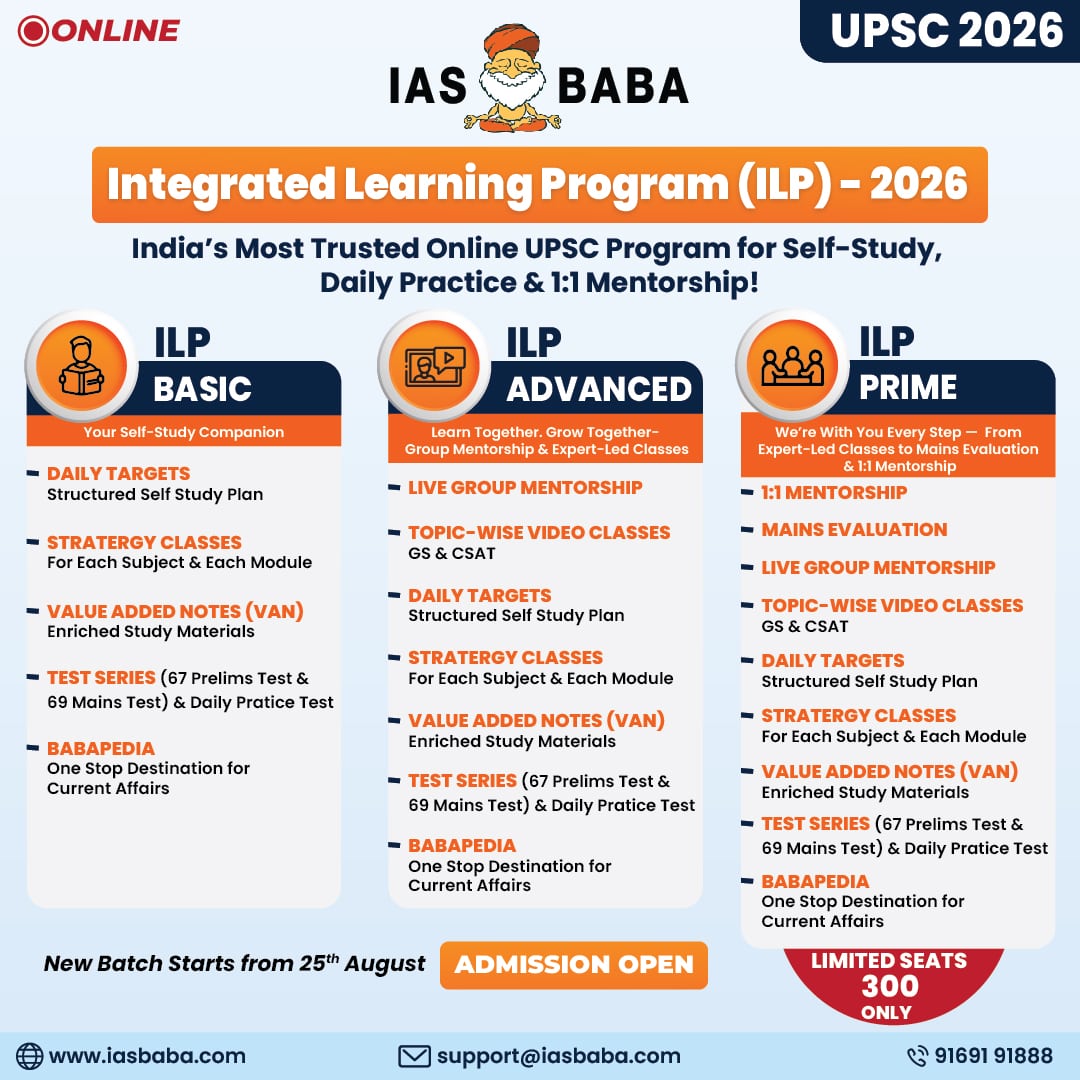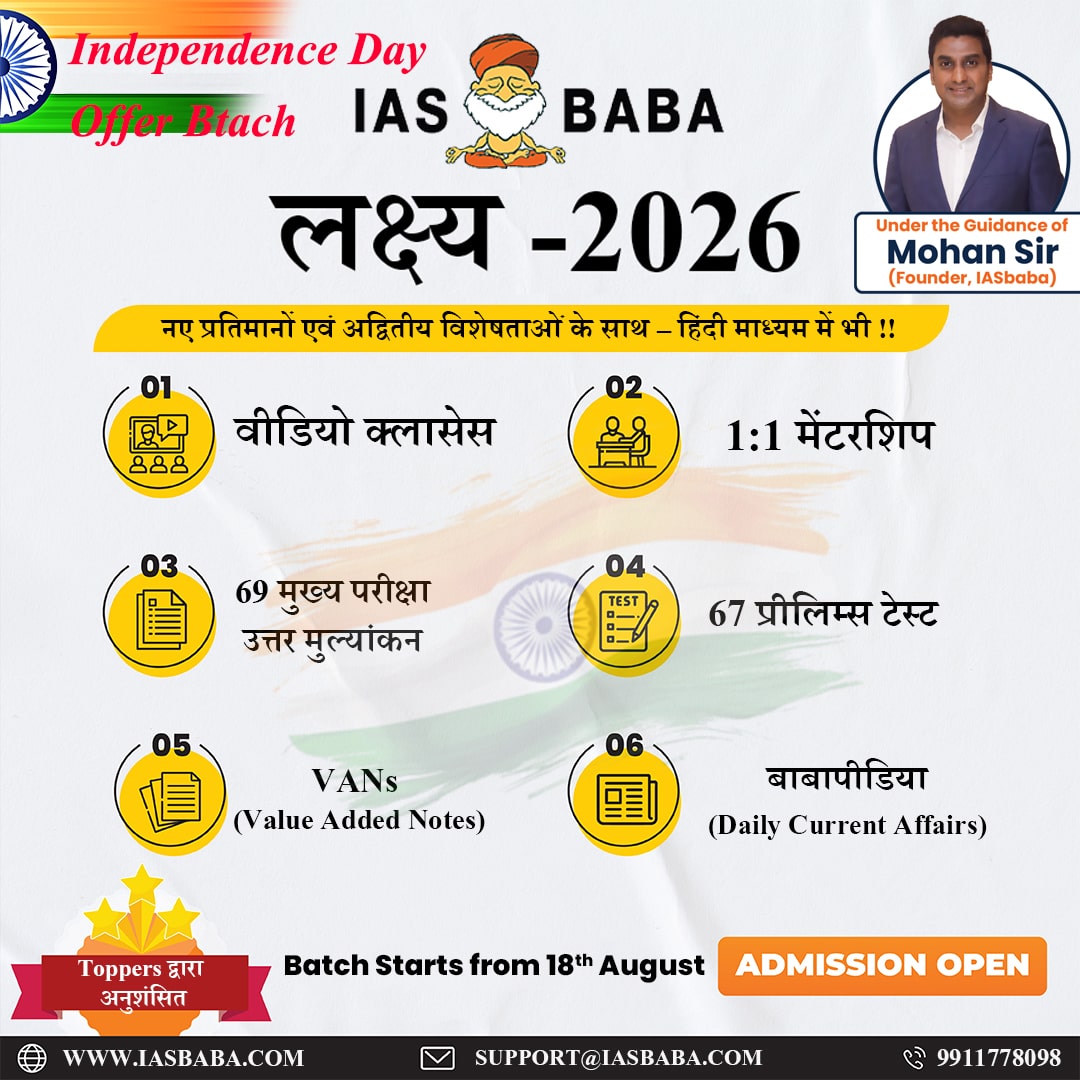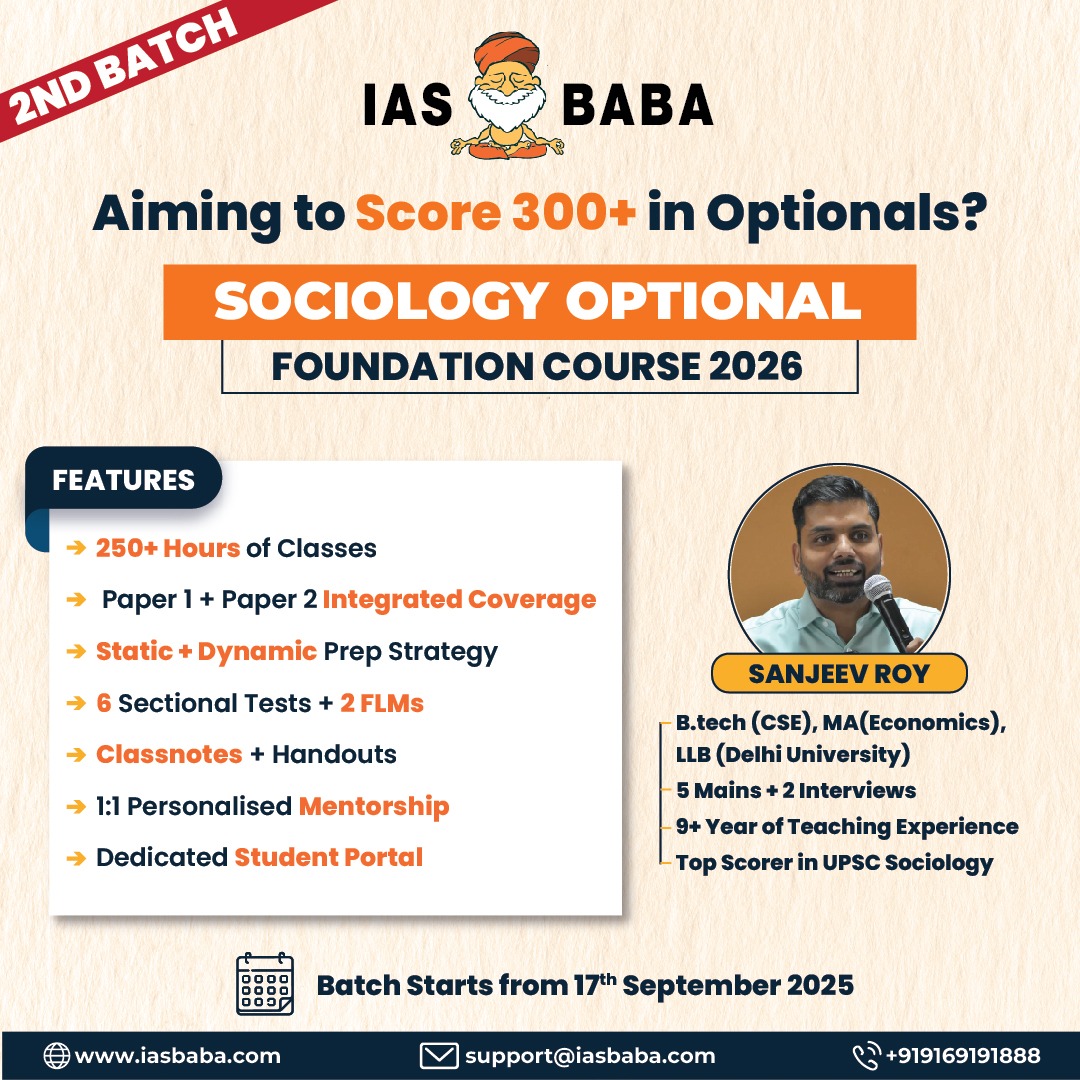IASbaba's Daily Current Affairs Analysis
Archives
(PRELIMS Focus)
Category: ENVIRONMENT
Context: Centre for Marine Living Resources and Ecology (CMLRE) Leads Urgent Ocean Study After Hazardous Cargo Spill off Kochi
Learning Corner:
The Centre for Marine Living Resources and Ecology (CMLRE), functioning under the Ministry of Earth Sciences, has initiated an emergency oceanographic study in response to the hazardous cargo and oil spill caused by the capsizing of the container ship MSC ELSA 3.
Key Actions and Focus Areas
- Rapid Assessment: CMLRE is conducting real-time ocean monitoring to evaluate both the immediate and long-term impacts of the spill on marine ecosystems, coastal habitats, and fisheries.
- Inter-Agency Coordination: The study is being carried out in collaboration with the Indian Coast Guard, National Disaster Response Force (NDRF), Customs, and various state agencies involved in containment, cleanup, and risk mitigation efforts.
- Environmental Impact: The incident has triggered a tier-2 maritime emergency response. There are serious concerns about toxic effects on marine biodiversity, the contamination of fish stocks, and the potential health risks to coastal populations.
- Public Safety Measures: Authorities have enforced a fishing ban within a 20-nautical-mile radius around the sunken ship and have issued advisories urging the public to avoid contact with any washed-up containers or oil-contaminated beaches.
- Ongoing Response: Ships, aircraft, and pollution control vessels have been deployed by the Indian Coast Guard to track and contain the oil slick. CMLRE’s scientific teams are actively collecting water, sediment, and marine life samples for laboratory analysis.
Significance
The study led by CMLRE is essential for:
- Determining the scale and severity of marine pollution.
- Guiding immediate cleanup and disaster mitigation efforts.
- Supporting long-term strategies for hazardous cargo management and marine disaster preparedness.
The findings are expected to play a critical role in minimizing ecological damage, safeguarding marine livelihoods, and enhancing India’s capacity to respond to future maritime environmental emergencies.
Source : PIB
Category: SCIENCE AND TECHNOLOGY
Context Indian Astronaut Gp Capt. Shubanshu Shukla to Study Human Adaptation and Cognitive Effects of Electronic Displays in Space
Group Captain Shubanshu Shukla, one of India’s upcoming astronauts, will lead a pioneering study on human adaptation in space during India’s next crewed space mission. A major focus will be on the cognitive effects of prolonged exposure to electronic displays in microgravity.
Key Research Objectives:
- Physical Adaptation: Monitoring changes in muscle mass, bone density, and cardiovascular health in a zero-gravity environment.
- Cognitive Performance: Evaluating memory, attention span, decision-making ability, and reaction time in space conditions.
- Physiological Health: Tracking sleep cycles, vital signs, and stress responses during extended space missions.
- Impact of Electronic Displays: Investigating how continuous interaction with screens used for navigation and communication affects vision, cognitive clarity, and psychological well-being.
Significance:
- Health and Safety: The findings will help improve astronaut training and onboard systems to ensure health and efficiency during long-duration missions, including future plans for India’s space station.
- Technology Design: Insights will guide the development of astronaut-friendly interfaces and display systems.
- Global Contribution: The research adds to the international understanding of human factors in spaceflight and supports global efforts in long-term space exploration.
This study is a significant milestone in India’s human spaceflight program, marking progress in both scientific research and space technology.
Learning Corner:
International Space Station (ISS) – Brief Note
The International Space Station (ISS) is a large, habitable spacecraft that orbits Earth at an altitude of approximately 400 km. It serves as a microgravity and space environment research laboratory, where scientific research is conducted in fields like astronomy, biology, physics, and Earth science.
Key Features:
- Launched: First module launched in 1998; continuously inhabited since 2000.
- Partnership: A collaborative project involving five major space agencies:
- NASA (USA),Roscosmos (Russia),ESA (Europe),JAXA (Japan),CSA (Canada)
Structure:
- Consists of pressurized modules for crew and labs, unpressurized truss segments for solar panels, and external payloads.
Crew:
- Typically hosts 6 astronauts from various countries; crews conduct experiments, maintain systems, and prepare for future deep space missions.
Significance:
- Scientific Research: Enables long-term studies on how microgravity affects the human body, plants, materials, and fluids—knowledge crucial for future Moon or Mars missions.
- International Cooperation: A symbol of peaceful collaboration among nations in space exploration.
- Technology Testing: A platform for testing advanced technologies such as life support systems, robotics, and artificial intelligence in space.
The ISS is expected to operate until 2030, after which commercial space stations or national stations like India’s Bharatiya Antariksh Station may take on similar roles in low Earth orbit.
Space Stations by Different Countries
- International Space Station (ISS) – Multinational
- Operational Since: 1998 (still active)
- Countries Involved: USA, Russia, Japan, Canada, 11 European nations
- Purpose: Scientific research, international collaboration, microgravity experiments
- Orbit: Low Earth Orbit (LEO), ~400 km altitude
- Tiangong Space Station – China
- Operator: China National Space Administration (CNSA)
- Operational Since: 2021
- Modules: Tianhe (core), Wentian, Mengtian
- Crew: Hosts 3 astronauts for long-duration missions
- Purpose: China’s independent orbital lab for space science, biology, and materials experiments
Past Chinese Stations:
- Tiangong-1 (2011–2016): Prototype space lab
- Tiangong-2 (2016–2019): Advanced version for testing life support and docking systems
- Mir – Soviet Union / Russia
- Operational: 1986–2001
- Significance: First modular space station; hosted long-duration human missions
- Legacy: Paved the way for ISS with lessons in orbital construction and habitation
- Salyut Series – Soviet Union
- Operational: 1971–1986
- Details: World’s first space stations; a series of 7 missions
- Purpose: Early experiments in microgravity, military surveillance (in Almaz variants)
- Skylab – United States (NASA)
- Operational: 1973–1979
- Details: First U.S. space station
- Experiments: Earth observation, solar physics, and medical studies
- Crewed Missions: 3, with durations up to 84 days
Future / Proposed Space Stations
Bharatiya Antariksh Station – India (ISRO)
- Planned Launch: By 2035 (tentative)
- Purpose: Long-term Indian human presence in space; research in microgravity and technology testing
Lunar Gateway – NASA-led (planned)
- Orbit: Lunar orbit (not Earth)
- Partners: NASA, ESA, JAXA, CSA
- Purpose: Support for Artemis missions and future Mars expeditions
Source : PIB
Category: SCIENCE AND TECHNOLOGY
Context : Recent research shows that bacteria isolated from the Rajgir hot spring exhibit notable antimicrobial activity.
Learning Corner:
Like other geothermal environments, Rajgir’s hot springs harbour thermophilic and extremophilic bacteria that produce valuable bioactive compounds, including antibiotics and enzymes. Genera such as Bacillus, Geobacillus, and Anoxybacillus are common and display antimicrobial properties against pathogens. The unique thermal and chemical conditions of Rajgir support bacteria that thrive at high temperatures and produce metabolites with antimicrobial effects. These bacteria hold significant potential for developing new antibiotics and various biotechnological applications.
What is antimicrobial activity
Antimicrobial activity refers to the ability of a substance or organism to kill or inhibit the growth of microorganisms such as bacteria, fungi, viruses, or parasites. It is a crucial property in medicine and biotechnology for controlling infections and diseases. Substances with antimicrobial activity include antibiotics, antiseptics, and natural compounds produced by certain bacteria and fungi. This activity helps prevent the spread of harmful microbes and is vital for developing new drugs, especially in the face of rising antibiotic resistance. Antimicrobial agents work by targeting essential processes in microbes, such as cell wall synthesis, protein production, or DNA replication.
Where is Rajgir hot spring?
Rajgir Hot Spring is a natural geothermal spring located in Rajgir, Bihar. Known for its warm, mineral-rich waters, it has been a site of cultural and therapeutic significance for centuries. The spring’s unique thermal and chemical properties create a habitat for thermophilic bacteria, which have potential applications in medicine and biotechnology. Besides its scientific importance, Rajgir Hot Spring attracts tourists and pilgrims due to its association with ancient religious traditions and its reputed healing qualities.
Source: THE HINDU
Category: SCIENCE AND TECHNOLOGY
Context : Researchers at the Indian Institute of Science (IISc), Bengaluru, have developed a novel artificial metal-based nanozyme that prevents excessive blood clotting without causing the bleeding risks commonly associated with traditional anti-clotting drugs.
This nanozyme is made from spherical vanadium pentoxide (V₂O₅) nanoparticles and mimics the action of the natural antioxidant enzyme glutathione peroxidase.
How It Works:
- The nanozyme regulates reactive oxygen species (ROS), which can trigger excessive platelet activation and dangerous clot formation in conditions like pulmonary thromboembolism and COVID-19.
- By modulating redox signalling, it prevents abnormal clotting without interfering with normal haemostasis, thus avoiding bleeding complications.
- Tests on human platelets and mouse models showed effective clot prevention and improved survival, with no observed toxicity.
Significance:
- Offers a safer alternative to conventional anti-clotting drugs by selectively targeting abnormal clot formation.
- The research team aims to explore its use in conditions like ischemic stroke.
- Human clinical trials are the next step in advancing this potentially life-saving innovation.
Learning Corner:
What is Nanozyme?
Nanozyme is a term for nanomaterials that mimic the activity of natural enzymes. These artificial enzymes are designed at the nanoscale and can perform specific biochemical reactions, such as breaking down harmful substances or regulating biological processes. Nanozymes are often more stable, cost-effective, and easier to produce than natural enzymes. They have wide applications in medicine, diagnostics, environmental cleanup, and biotechnology. Recent research has shown their potential in treating diseases like thrombosis by targeting harmful reactions in the body without causing side effects common with traditional drugs.
Applications of Nano Technology
- Medicine and Healthcare
-
- Drug Delivery: Nanoparticles can deliver drugs directly to diseased cells, improving effectiveness and reducing side effects.
- Diagnostics: Used in imaging techniques (e.g., MRI, biosensors) for early and accurate disease detection.
- Therapy: Nanozymes and other nanomaterials are being explored for treating cancer, blood clots, and infections.
- Electronics and Computing
- Miniaturization: Used in the manufacture of smaller, faster, and more efficient transistors and microchips.
- Sensors: Enable highly sensitive sensors for detecting gases, toxins, or biological markers.
- Energy Sector
- Solar Cells: Improve light absorption and efficiency in photovoltaic devices.
- Batteries and Fuel Cells: Enhance storage capacity, charging speed, and lifespan of batteries.
- Environmental Applications
- Water Purification: Nanomaterials like carbon nanotubes and nano-iron remove contaminants and pathogens.
- Pollution Control: Capture pollutants or break them down into harmless substances.
- Textiles and Consumer Goods
- Smart Fabrics: Impart properties like water repellence, UV protection, and odor resistance.
- Durability: Improve fabric strength and wear resistance.
- Agriculture
- Nano-Fertilizers and Pesticides: Provide controlled and efficient delivery of nutrients and chemicals.
- Sensors: Monitor soil health, moisture, and crop conditions in real time.
- Construction and Materials
- Stronger Materials: Nanoparticles enhance strength, flexibility, and durability of concrete, steel, and coatings.
- Self-Healing Materials: Certain nanomaterials can help structures repair minor cracks or damage.
- Cosmetics and Personal Care
- Skin Care: Improve the absorption and effectiveness of ingredients in sunscreens and anti-aging products.
- Safety: Better control over product behaviour at the molecular level.
Source : THE HINDU
Category: POLITY
Context : The government is set to introduce a motion of impeachment against Justice Yashwant Varma, currently of the Allahabad High Court, during the upcoming Monsoon Session of Parliament
This unprecedented move follows the findings of a Supreme Court-appointed three-member inquiry panel, which indicted Justice Varma over allegations of unaccounted cash discovered at his official residence in Delhi after a fire on March 14, 2025. The panel concluded that Justice Varma failed to satisfactorily explain the source of the large quantity of burnt currency notes, deeming the misconduct serious enough to warrant impeachment proceedings.
Despite being urged by the Supreme Court to resign, Justice Varma has refused, prompting the government to initiate the impeachment process. Parliamentary Affairs Minister Kiren Rijiju has been tasked with building consensus and engaging with leaders of all major political parties to ensure bipartisan support for the motion. The Congress and other opposition parties have indicated they are likely to support the move, viewing it as a matter of judicial accountability rather than political rivalry.
Under the Constitution and the Judges (Inquiry) Act, 1968, an impeachment motion against a High Court judge requires the support of at least 100 Lok Sabha or 50 Rajya Sabha members to be tabled, and must then be passed by a two-thirds majority in both Houses. Since the Supreme Court has already conducted a thorough inquiry, Parliament can proceed directly to the motion without forming a new investigative committee.
If passed, this would mark the first-ever impeachment of a High Court judge in India, underscoring the seriousness of the allegations and the emphasis on upholding public trust in the judiciary. The case has triggered wider debates on judicial accountability and the mechanisms for ensuring integrity within the higher judiciary.
Learning Corner:
Impeachment Procedure of High Court and Supreme Court Judges in India
- Grounds: A judge can be impeached for proven misbehaviour or incapacity as per Article 124(4) of the Constitution (also applicable to High Court judges via Article 218).
- Initiation:
- Requires a notice signed by 100 Lok Sabha MPs or 50 Rajya Sabha MPs.
- Notice is submitted to the Speaker (Lok Sabha) or Chairman (Rajya Sabha).
- Inquiry Committee:
- Normally, if the presiding officer admits the motion, a three-member committee (Judge of SC, Chief Justice of HC, and a distinguished jurist) is formed to investigate.
- Exception: If an inquiry has already been conducted by a Supreme Court-appointed committee, Parliament can skip forming a new one (as in the Varma case).
- Parliamentary Approval:
- If the judge is found guilty, the motion must be passed in both Houses by:
- A majority of total membership, and
- A two-thirds majority of members present and voting.
- If the judge is found guilty, the motion must be passed in both Houses by:
- Presidential Assent:
- Once passed by Parliament, the President of India issues the order for removal of the judge.
Source: THE HINDU
(MAINS Focus)
| Date: 4-06-2025 | Mainspedia | |
| TOPIC: Jobs and domicile regulations in Ladakh | GS Paper II – Polity | |
| Introduction (Context)
The Centre has notified a series of regulations for Ladakh’s land, jobs, and cultural preservation, aimed at addressing concerns raised by the civil society in Ladakh over the past five years. This move comes amid continued demands for Sixth Schedule status and increasing activism led by the Leh Apex Body (LAB), Kargil Democratic Alliance (KDA), and prominent figures like Sonam Wangchuk. |
||
| About the new rules |
|
|
| How are the new regulations different? |
|
|
| Significance |
|
|
| Challenges |
|
|
| Value addition | About Sixth Schedule
Key Features:
Relevance to Ladakh:
|
|
| Way forward |
|
|
| Conclusion
The 2025 regulations for Ladakh mark a significant milestone in the Union Territory’s journey toward administrative and cultural recognition. By introducing domicile-based job reservations, expanding affirmative action in education, and recognizing local languages, the Centre has responded to long-standing demands of Ladakhi civil society. However, these executive measures fall short of providing constitutional guarantees that would ensure lasting protection for the region’s identity, resources, and autonomy. |
||
Mains Practice Question
Q “While the recent regulations for Ladakh address some regional demands, they fall short of constitutional safeguards.” Critically evaluate this statement in the context of Ladakh’s demand for Sixth Schedule status. (250 words, 15 marks)
| Date: 4-06-2025 | Mainspedia | |
| TOPIC: Mustard oil Policy and regulation | GS Paper III – Science and Technology
GS Paper II – Governance |
|
| Introduction (Context)
Mustard oil is one of the most commonly used cooking oils in India, especially in northern and eastern states. However, its safety for human health has become a matter of national debate due to the presence of a chemical called erucic acid, which is found in high quantities in Indian mustard oil. |
||
| Government rules regarding it | In recent years, two major developments have occured:
Both decisions were aimed at protecting people’s health. But experts believe that these steps, though well-intentioned, may not solve the real problem. |
|
| Verdict 1 by FSSAI |
Ban on Blended Mustard Oil (2021)
|
|
| What is Erucic acid |
|
|
| Alternatives |
Edible Oil Blending
Solution:
In Indian mustard, erucic acid is very high (40–54%) and ban of blending will increase the health risks. |
|
| Verdict 2 by Supreme Court |
|
|
| Value addition | About DMH-11
|
|
| Conclusion
Both decisions, the FSSAI ban and SC verdict on GM mustard aim to protect health, but neither fully addresses the core problem of high erucic acid in mustard oil. India needs a balanced strategy to regulate and allow safe oil blending and accelerate development of low-erucic GM mustard. |
||
Mains Practice Question
Q Examine the implications of banning blended mustard oil in the context of public health and suggest a balanced regulatory approach. (250 words, 15 marks)
Daily Practice MCQs
Today’s – Daily Practice MCQs’ will be updated in our “Daily Current Affairs Quiz” section on our website
Please click on the below link












